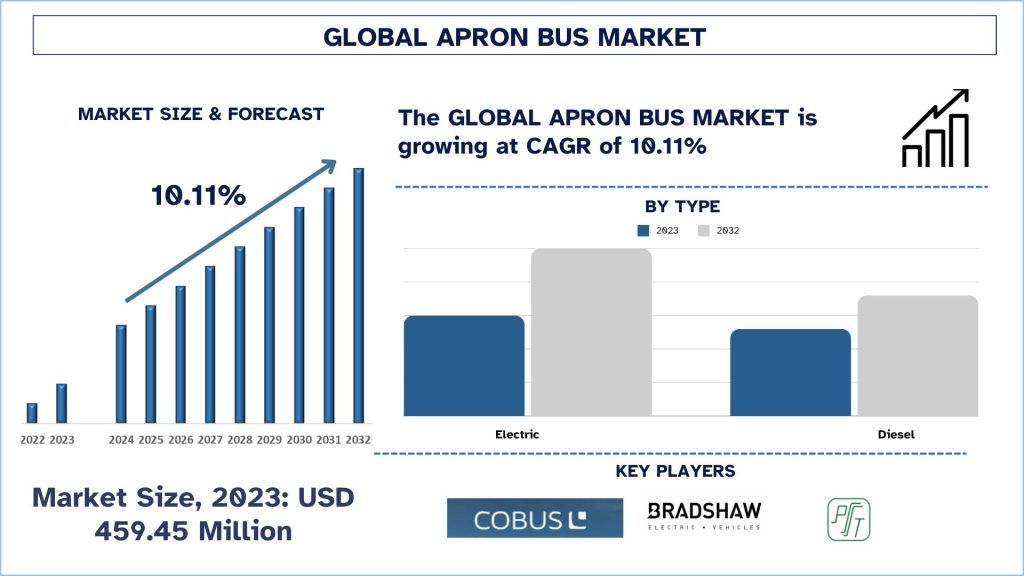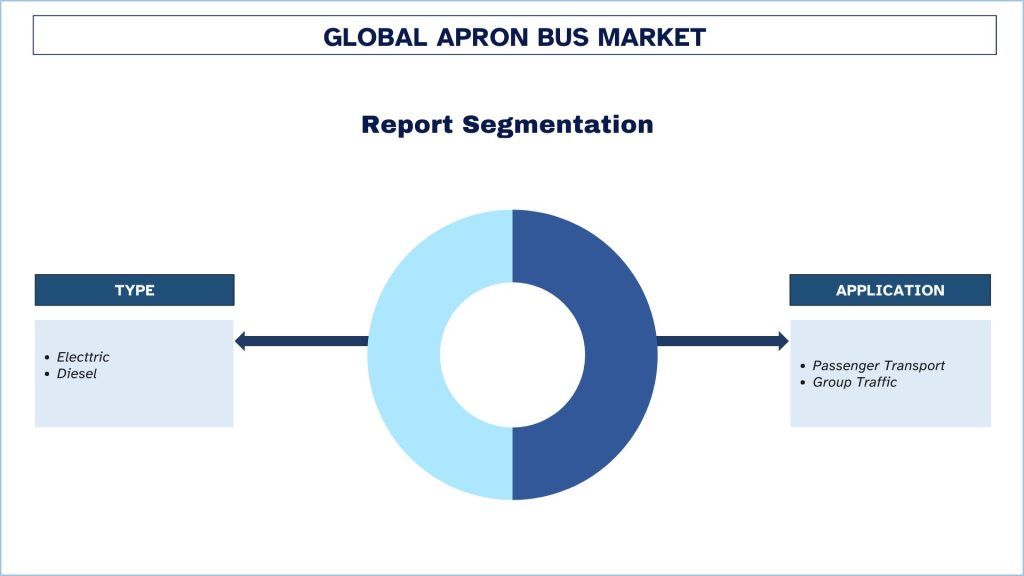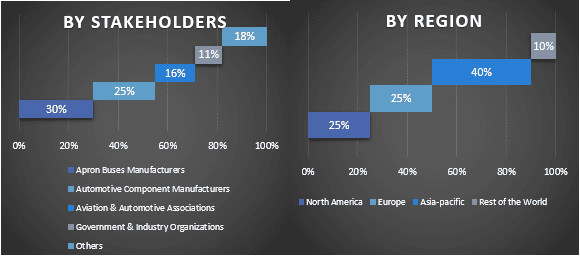Apron Bus Market: Current Analysis and Forecast (2024-2032)
Emphasis on By Type (Electric, Diesel), By Application (Passenger Transport, Group Traffic), and Regions (North America (The US, Canada, Rest of North America), Europe (Germany, The UK, France, Italy, Spain, Rest of the Europe), Asia-pacific (China, Japan, India, Rest of the Asia-pacific), Rest of the World)
 Global Apron Bus Market Size & Forecast
Global Apron Bus Market Size & Forecast
The Global Apron Bus Market was valued at USD 459.45 million in 2023 and is expected to grow at a strong CAGR of around 10.11% during the forecast period (2024-2032) owing to rising demand for Apron Bus in the aviation industry across the globe.
Global Apron Bus Market Analysis
Apron buses are used to commute people from the terminal to their intended aircraft prepared for traveling. These buses carry both air traffic and staff from one place in the airport to another. The market has witnessed a rapid surge in recent years due to the rise of the aviation industry, with a burgeoning middle-class population opting for air travel, both domestic and international. This phenomenon has stressed the need to expand aviation services through the purchase of a large number of aircraft as well as the rapid development of airports and newer runways, further promoting the need for apron buses to cater to air traffic.
The Global Apron Bus Market was valued at USD 459.45 million in 2023 and is expected to grow at a strong CAGR of around 10.11% during the forecast period (2024-2032). One of the key factors that have supported the demand for apron buses is the rise in the air travel infrastructure through the development of newer runways and airports. The increasing number of airports across the globe has also assisted the demand for newer apron buses to be purchased and used for air traffic commutes through the terminals to the intended aircraft. For instance, in 2024, The U.S. Department of Transportation’s Federal Aviation Administration (FAA), announced to invest USD289 million for 129 airports in 40 states of the US for improving the safety and efficiency of air travel. The investment is part of a mega USD 25 billion investment for funding the airport improvement through terminal expansion, baggage systems upgrade, runway enhancement, and air traffic infrastructure improvements.
In another instance, in 2024, the government of Portugal announced the construction of a mega airport, Lisbon’s Humberto Delgado Airport, with a total cost of USD 10.64 billion.
Considering the expansion of air travel infrastructure on a mass scale the demand for apron buses in the respective projects is anticipated to fuel the demand for apron buses.

Global Apron Bus Market Trends
This section discusses the key market trends that are influencing the various segments of the Global Apron Bus Market as identified by our team of research experts.
Rising Low-Cost Carrier Operations in Developing Regions
Many low-cost carrier companies have emerged in the region, offering budget airline services for domestic and international air travel in countries such as India, China, Thailand, Indonesia, South Korea, Australia, Japan, etc. Considering the high demand for low-cost carriers, the airport expansions and purchase of new aircraft have increased, leading to the rising demand for apron buses for commute. Some of the key low-cost carrier service providers in the region are Indigo, GoAir, AirAsia, Scoot, Nok Air, Jetstar, Citilink, Beijing Airlines, etc. Some of the countries where LCC holds a sizeable share in airline services are Southeast Asia and South Asia region, where countries such as India, Indonesia, Thailand, Malaysia, and the Philippines hold 74%, 63%, 57%, 51%, and 58%, respectively which is above 50% of total passenger flying. The respective share is further anticipated to increase in the coming years as middle-class income is burgeoning, which would fuel the demand for budget airline services. In line with this, many of the LCCs have announced their plans to invest in adding new aircraft to the fleet in the coming years.
With the growing need for low-cost carriers in the aviation industry, the demand for Apron Bus in this particular category is anticipated to find rapid growth, subsequently improving Apron Bus Market in the coming years.

Asia Pacific is Expected to Hold Major Market Share During Forecast Period
Asia Pacific region is anticipated to exhibit a sizeable growth during 2024-2032. Some of the key factors attributing to the growth are the rise of the aviation industry in the region, stringent government policies to improve passenger experience and safe air travel, companies focusing on smoothening airport operations, etc. As the region is experiencing a surge in air traffic, many aviation players are planning to expand their operations to tap the rising market opportunity. Additionally, the region is also home to a thriving low-cost carrier market as air travel in countries such as China, India, Indonesia, Thailand, Singapore, etc., are experiencing a surge in air traffic. Many of the countries in the region have announced that they will expand their operations in the regions. For instance, In 2023, ANA Holdings announced the launch of a new airline named AirJapan by 2024-2025, which would fly from Japan to other Asian countries.
Another low-cost carrier from Japan Airlines (JAL Group), launched in 2020, announced to expand its budget airlines services San Francisco International Airport (SFO) and Tokyo’s Narita International Airport (NRT), with one-way fares as low as USD 325 in 2023.
Many key airlines in the region have announced their plans to expand their fleet through the acquisition of new aircraft. For instance, in 2023, Indigo announced the acquisition of 500 new Airbus A320 aircraft with a total cost of USD 50 billion. All the deliveries will take place by 2030-2035, showing an upcoming robust growth of the low-cost carrier market in India in the coming years, i.e., 2023-2030.
Considering the vast unfilled orders that are to be delivered in the coming years, the demand for apron bus services for smooth terminal commute to runways is anticipated to rise in the forecasted years, i.e., 2024-2032.
Global Apron Bus Industry Overview
The Global Apron Bus Market is competitive and fragmented, with the presence of several global and international market players. The key players are adopting different growth strategies to enhance their market presence, such as partnerships, agreements, collaborations, new product launches, geographical expansions, and mergers and acquisitions. Some of the major players operating in the market are Cobus Industries, Aeromobiles, and Bradshaw Electric Vehicles, Kiitikori Oy, Power Force Technologies, WeihaiGuangtai Airport Equipment, Zhengzhou Yutong Bus, XINFA Airport Equipment, CIMC Tinda, and BYD.
Global Apron Bus Market News
According to Boeing Corporation between 2023-2042 a total number of 32,420 narrowbody aircrafts would be delivered of this nearly 40% would be used for the low-cost carrier operations across the globe.
In 2023, Indigo announced to buy 500 new Airbus A320 aircraft with the total cost of USD 50 billion. All the deliveries will take place by 2030-2035 showing an upcoming robust growth of low-cost carrier market in India in the coming years i.e., 2023-2030.
Global Apron Bus Market Report Coverage
Report Attribute | Details |
Base year | 2023 |
Forecast period | 2024-2032 |
Growth momentum | Accelerate at a CAGR of 10.11% |
Market size 2023 | USD 459.45 million |
Regional analysis | North America, Europe, Asia-pacific, Rest of the World |
Major countries | The US, Canada, The UK, France, Germany, Italy, Spain, China, Japan, India |
Companies profiled | Cobus Industries, Aeromobiles, Bradshaw Electric Vehicles, Kiitikori Oy, Power Force Technologies, WeihaiGuangtai Airport Equipment, Zhengzhou Yutong Bus, XINFA Airport Equipment, CIMC Tinda, and BYD. |
Report Scope | Market Trends, Drivers, and Restraints; Revenue Estimation and Forecast; Segmentation Analysis; Demand and Supply Side Analysis; Competitive Landscape; Company Profiling |
Segments Covered | By Type, By Application, By Region/Country |
Reasons to buy this report:
- The study includes market sizing and forecasting analysis validated by authenticated key industry experts.
- The report presents a quick review of overall industry performance at one glance.
- The report covers an in-depth analysis of prominent industry peers with a primary focus on key business financials, product portfolios, expansion strategies, and recent developments.
- Detailed examination of drivers, restraints, key trends, and opportunities prevailing in the industry.
- The study comprehensively covers the market across different segments.
- Deep dive regional level analysis of the industry.
Customization Options:
The Global Apron Bus Market can further be customized as per the requirement or any other market segment. Besides this, UMI understands that you may have your own business needs; hence, feel free to connect with us to get a report that completely suits your requirements.
Table of Contents
Research Methodology for the Global Apron Bus Market Analysis (2024-2032)
Analyzing the historical market, estimating the current market, and forecasting the future market of the Global Apron Bus Market were the three major steps undertaken to create and analyze the adoption of Global Apron Bus in major regions globally. Exhaustive secondary research was conducted to collect the historical market numbers and estimate the current market size. Secondly, to validate these insights, numerous findings and assumptions were taken into consideration. Moreover, exhaustive primary interviews were also conducted with industry experts across the value chain of the Global Apron Bus Market. Post assumption and validation of market numbers through primary interviews, we employed a top-down/bottom-up approach to forecasting the complete market size. Thereafter, market breakdown and data triangulation methods were adopted to estimate and analyze the market size of segments and sub-segments of the industry. Detailed methodology is explained below:
Analysis of Historical Market Size
Step 1: In-Depth Study of Secondary Sources:
Detail secondary study was conducted to obtain the historical market size of the Global Apron Bus Market through company internal sources such as annual reports & financial statements, performance presentations, press releases, etc., and external sources including journals, news & articles, government publications, competitor publications, sector reports, third-party database, and other credible publications.
Step 2: Market Segmentation:
After obtaining the historical market size of the Global Apron Bus Market, we conducted a detailed secondary analysis to gather historical market insights and share for different segments & sub-segments for major regions. Major segments are included in the report as by type and by application. Further regional/country-level analyses were conducted to evaluate the overall adoption of testing models in that region.
Step 3: Factor Analysis:
After acquiring the historical market size of different segments and sub-segments, we conducted a detailed factor analysis to estimate the current market size of the Global Apron Bus Market. Further, we conducted factor analysis using dependent and independent variables such as by type and by application in the Global Apron Bus Market. A thorough analysis was conducted for demand and supply-side scenarios considering top partnerships, mergers and acquisitions, business expansion, and product launches in the Global Apron Bus Market sector across the globe.
Current Market Size Estimate & Forecast
Current Market Sizing: Based on actionable insights from the above 3 steps, we arrived at the current market size, key players in the Global Apron Bus Market, and market shares of the segments. All the required percentage shares split, and market breakdowns were determined using the above-mentioned secondary approach and verified through primary interviews.
Estimation & Forecasting: For market estimation and forecast, weights were assigned to different factors, including drivers & trends, restraints, and opportunities available for the stakeholders. After analyzing these factors, relevant forecasting techniques, i.e., the top-down/bottom-up approach, were applied to arrive at the market forecast for 2032 for different segments and sub-segments across the major markets globally. The research methodology adopted to estimate the market size encompasses:
- The industry’s market size, in terms of revenue (USD) and the adoption rate of the Global Apron Bus Market across the major markets domestically
- All percentage shares, splits, and breakdowns of market segments and sub-segments
- Key players in the Global Apron Bus Market in terms of products offered. Also, the growth strategies adopted by these players to compete in the fast-growing market.
Market Size and Share Validation
Primary Research: In-depth interviews were conducted with the Key Opinion Leaders (KOLs), including Top Level Executives (CXO/VPs, Sales Head, Marketing Head, Operational Head, Regional Head, Country Head, etc.) across major regions. Primary findings were then summarized, and statistical analysis was performed to prove the stated hypothesis. Inputs from primary research were consolidated with secondary findings, hence turning information into actionable insights.
Split of Primary Participants in Different Regions

Market Engineering
The data triangulation technique was employed to complete the overall market estimation and to arrive at precise statistical numbers for each segment and sub-segment of the Global Apron Bus Market. Data was split into several segments and sub-segments after studying various parameters and trends in the by type and by application in the Global Apron Bus Market.
The main objective of the Global Apron Bus Market Study
The current & future market trends of the Global Apron Bus Market were pinpointed in the study. Investors can gain strategic insights to base their discretion for investments on the qualitative and quantitative analysis performed in the study. Current and future market trends determined the overall attractiveness of the market at a regional level, providing a platform for the industrial participant to exploit the untapped market to benefit from a first-mover advantage. Other quantitative goals of the studies include:
- Analyze the current and forecast market size of the Global Apron Bus Market in terms of value (USD). Also, analyze the current and forecast market size of different segments and sub-segments.
- Segments in the study include areas of by type and by application.
- Define and analyze the regulatory framework for Global Apron Bus Market in the aviation industry.
- Analyze the value chain involved with the presence of various intermediaries, along with analyzing customer and competitor behaviors of the industry.
- Analyze the current and forecast market size of the Global Apron Bus Market for the major regions.
- Major countries of regions studied in the report include North America (The US, Canada, and Rest of North America), Europe (The UK, France, Germany, Italy, Spain, Rest of Europe), Asia-pacific (China, Japan, India, Rest of the Asia-pacific), Rest of the World
- Company profiles of the Global Apron Bus Market and the growth strategies adopted by the market players to sustain in the fast-growing market.
- Deep dive regional level analysis of the industry
Frequently Asked Questions FAQs
Q1: What is the current market size and growth potential of the Global Apron Bus market?
Q2: What are the driving factors for the growth of the Global Apron Bus market?
Q3: Which segment has the largest share of the Global Apron Bus market by type?
Q4: Which region will dominate the Global Apron Bus market?
Related Reports
Customers who bought this item also bought










